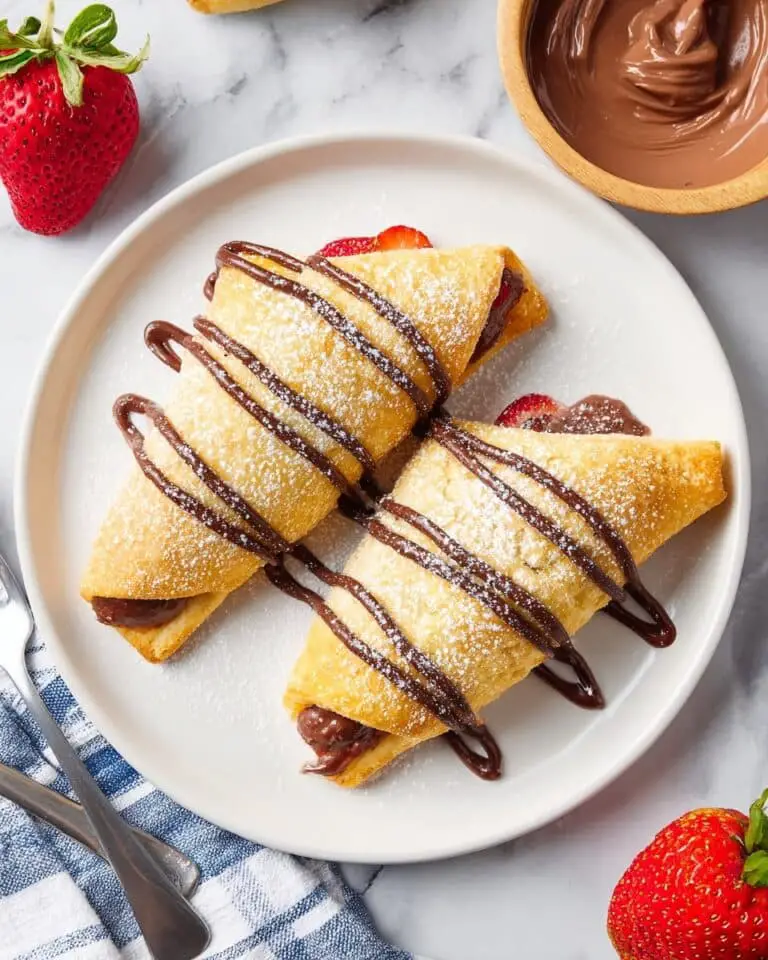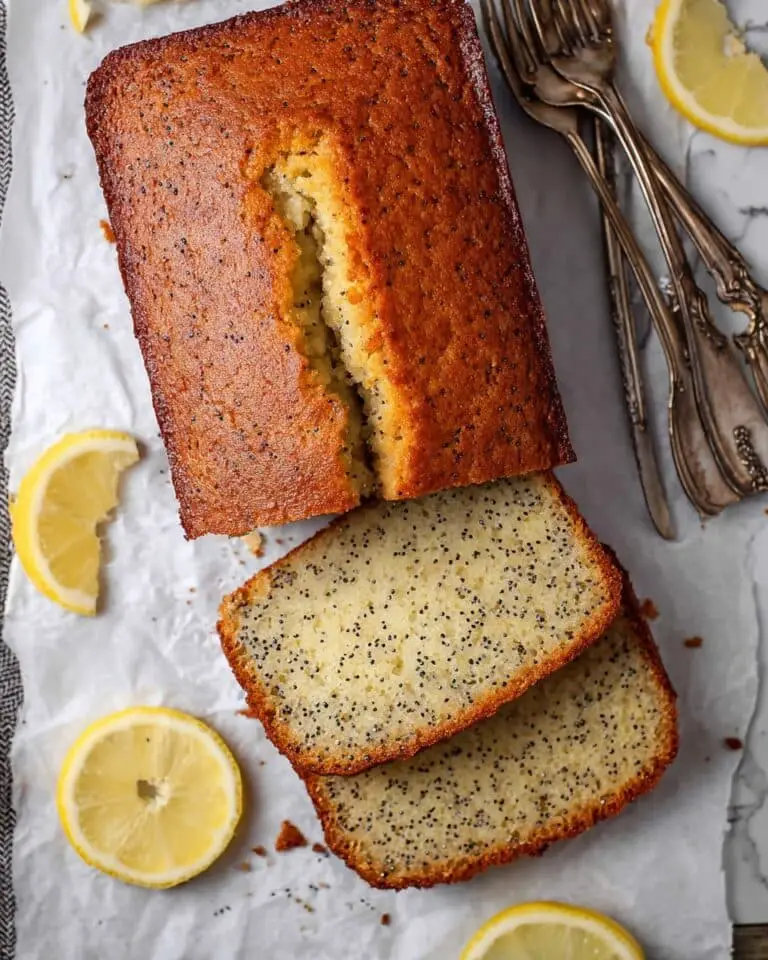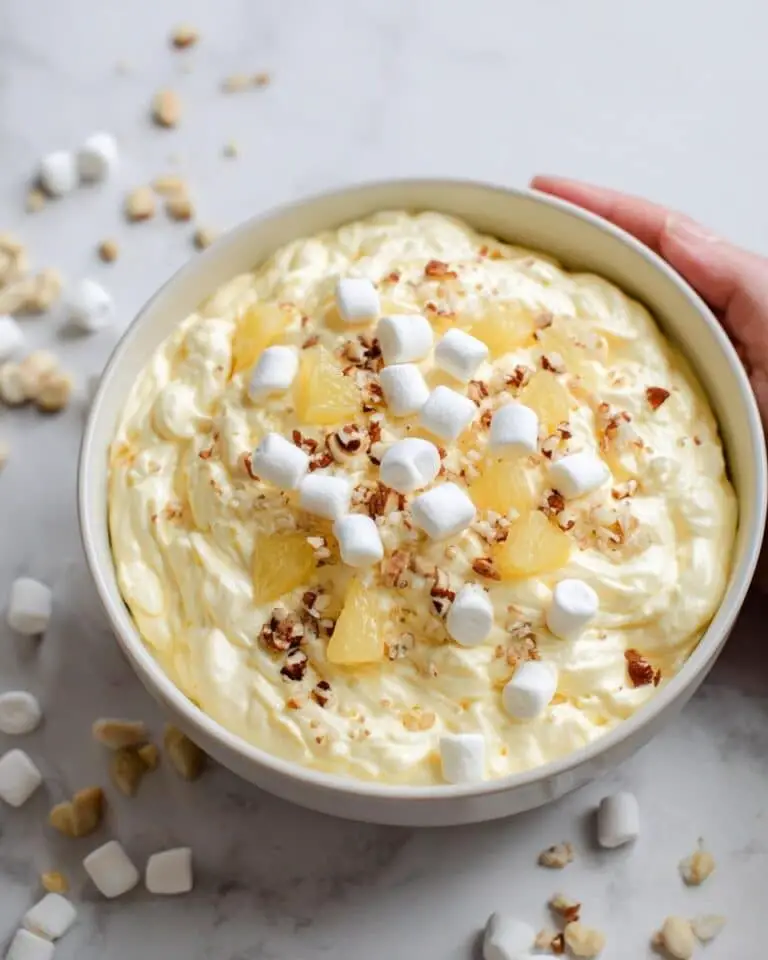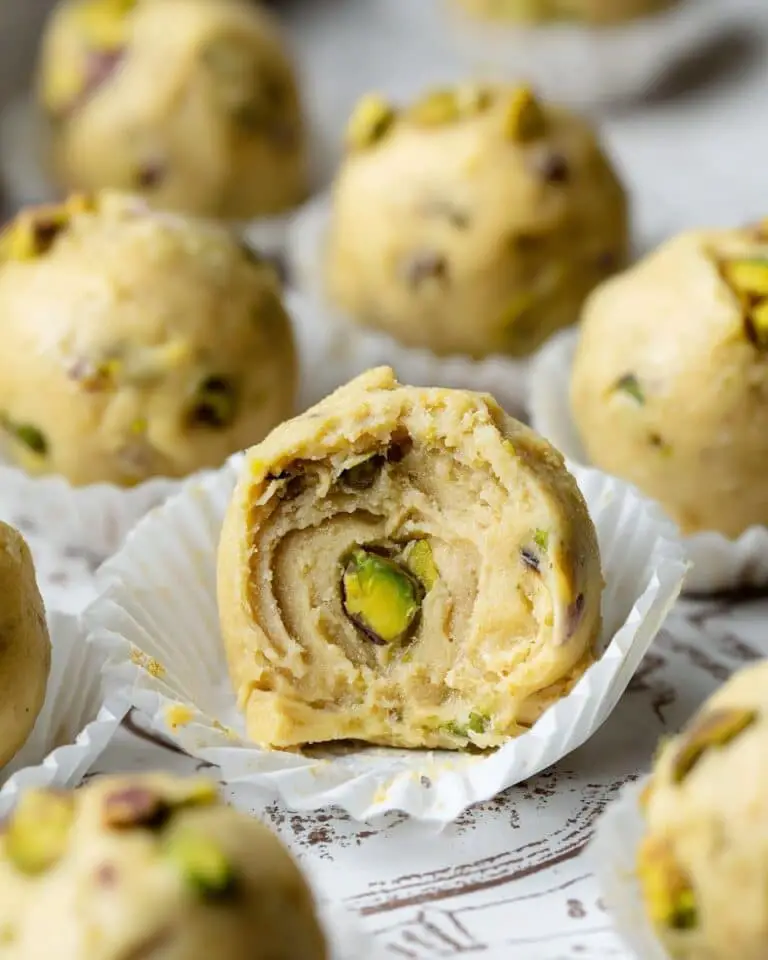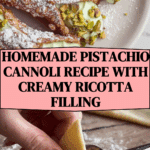If you’re craving a dessert that brings together crunch, creaminess, and a hint of nutty elegance, this Pistachio Cannoli Recipe is your ultimate indulgence. With its crisp, golden shells and luscious pistachio-infused ricotta filling, every bite is a delightful adventure that transports you straight to the heart of Italian tradition. The combination of crunchy cannoli shells and smooth, flavorful filling makes this dessert not only unforgettable but also perfect for sharing with friends and family.
Ingredients You’ll Need
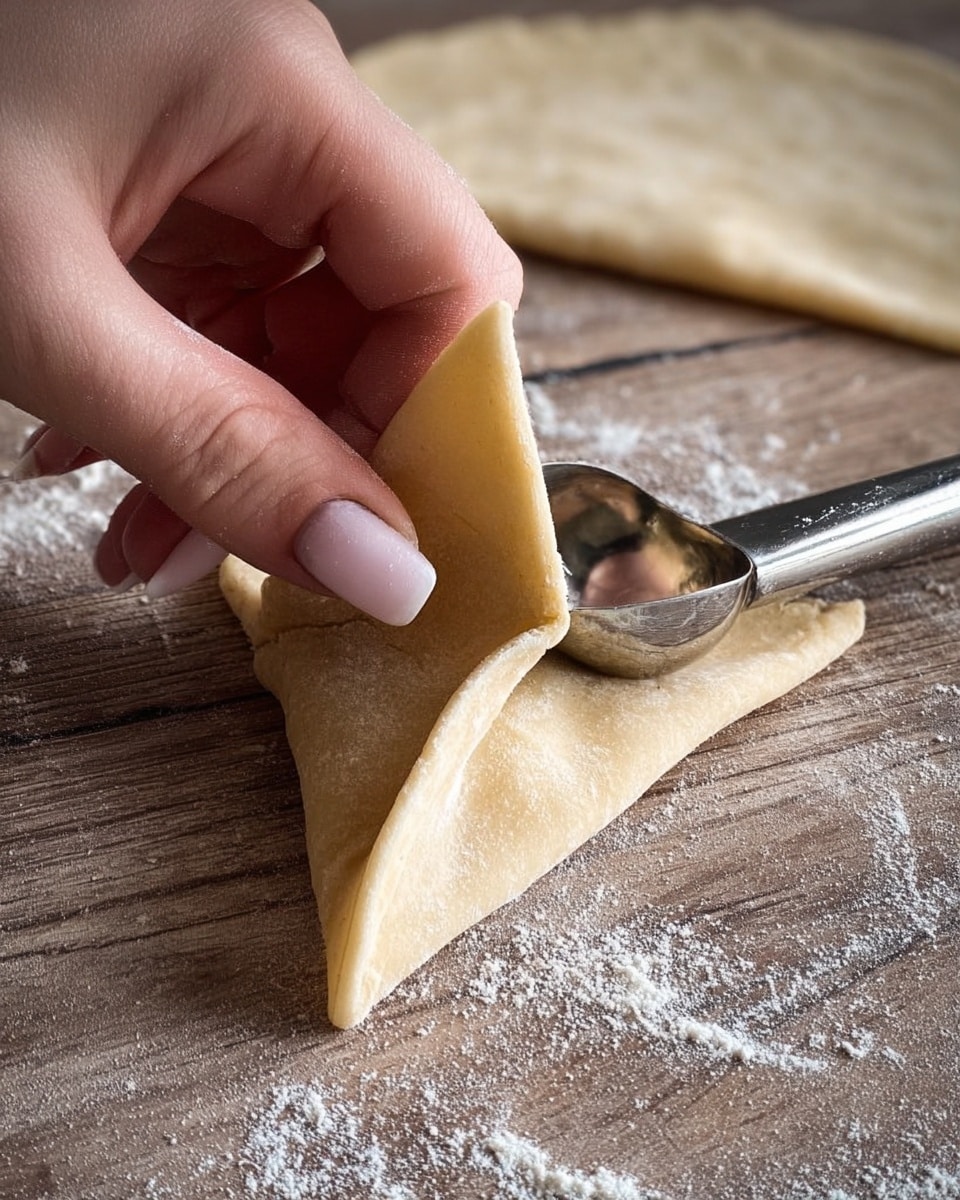
These ingredients are wonderfully straightforward yet play a crucial role in delivering the authentic taste and texture of this Pistachio Cannoli Recipe. Each one contributes uniquely—whether it’s the buttery crunch of the shells or the rich, creamy filling enriched with pistachio flavor.
- 1 3/4 cups All-purpose flour (250g): The foundation for your crispy cannoli shells, flour gives structure and texture.
- 2 tbsp Granulated Sugar (25g): Adds a touch of sweetness to balance the flavors.
- 1/4 tsp Salt: Enhances all the subtle flavors in the dough.
- 3 tbsp Unsalted Butter (43g, room temperature): Provides richness and flakiness to the shells.
- 1 Large Egg: Binds the dough while contributing to tenderness.
- 1/3 cup Marsala Wine (80ml): Imparts a classic aromatic depth and helps with dough elasticity.
- Frying oil: Enough for about 3 inches in your pan to ensure perfect frying.
- 32 oz Ricotta (900g, strained): The creamy heart of the filling, needs to be well-drained for the best texture.
- 1 1/2 cups Powdered Sugar (195g): Sweetens the ricotta filling smoothly.
- 1/4 tsp Ground Cinnamon: Adds a warm, gentle spice to the filling.
- 1 tsp Vanilla Extract: Brings out the flavors with a fragrant, sweet note.
- 2 tbsp Pistachio Paste: The star ingredient that infuses the filling with that irresistible pistachio flavor.
- Chopped Pistachios (optional): For dipping the ends, adding extra crunch and vibrant color.
How to Make Pistachio Cannoli Recipe
Step 1: Prepare the Ricotta
The night before you plan to assemble your cannoli, strain your ricotta thoroughly. This step is essential to remove any excess moisture, giving you a thick, creamy filling that won’t drip or become watery inside the shells. Letting it sit overnight ensures the perfect consistency.
Step 2: Create the Cannoli Shell Dough
Start by mixing flour, sugar, and salt in a large bowl. Then, work in the room-temperature butter until the texture resembles coarse breadcrumbs. This may take a bit of patience if done by hand, but the resulting flakiness is worth it. Add the egg and Marsala wine gently, mixing just until the dough forms a rough ball. Don’t overwork it to keep the shells tender but crisp.
Step 3: Knead and Rest the Dough
Transfer the dough onto a floured surface to knead it smoothly. The dough needs to be elastic enough to roll out super thin, so working it well is key. Once smooth, shape it into a round, wrap in plastic, and let it rest on the counter for two hours. This resting period allows the gluten to relax for easier rolling.
Step 4: Roll and Cut the Dough
Once rested, roll the dough as thin as you possibly can—ideally thin enough that you can see your fingers through it. A pasta maker can speed up this delicate process, but a rolling pin and patience works perfectly well. Cut into circles sized to suit your cannoli tubes, keeping in mind the length and diameter you prefer for your shells.
Step 5: Shape the Shells
Wrap each dough circle around cannoli tubes, sealing the edge with a bit of egg wash to prevent unravelling during frying. Press firmly on the seam to ensure tight closure and a neat final shape. This step helps your shells keep their iconic hollow tube form, ready to be filled later.
Step 6: Fry the Cannoli Shells
Heat your oil to about 350°F (180°C) and carefully submerge your shaped dough tubes. The shells cook quickly, so keep an eye and gently turn them every 30 seconds for even golden browning. After frying, place them on paper towels to drain and cool before carefully sliding them off the tubes. Reuse the tubes for the next batch of shells, making this a streamlined process.
Step 7: Make the Pistachio Filling
In a bowl, beat together your strained ricotta, powdered sugar, cinnamon, and vanilla extract until perfectly smooth. Slowly mix in the pistachio paste to taste, allowing your personal preference to guide the pistachio intensity. This heavenly filling balances sweet creaminess with nutty richness beautifully.
Step 8: Assemble and Fill
Transfer the pistachio filling to a piping bag, snip the end, and pipe the creamy mixture carefully into your cooled shells right before serving. For an extra finishing touch, dip the ends of your cannoli into chopped pistachios or chocolate chips to add crunch and visual appeal.
How to Serve Pistachio Cannoli Recipe
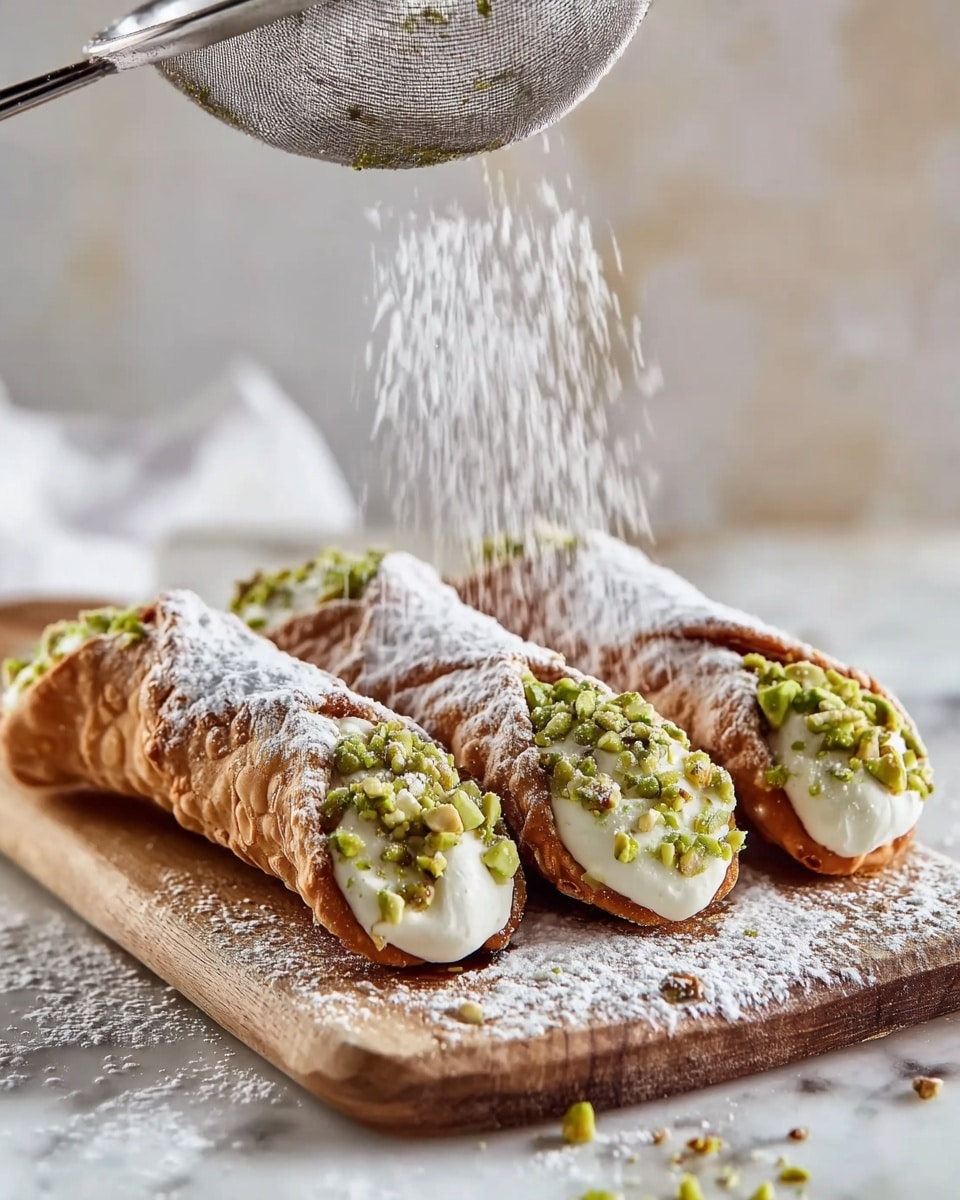
Garnishes
Garnishing your Pistachio Cannoli Recipe with chopped pistachios not only adds a satisfying crunch but also amps up the nutty flavor and makes your presentation spectacular. You can also dust a light sprinkle of powdered sugar or even some mini chocolate chips on the ends for a fun twist.
Side Dishes
Keep your sides simple to let these rich cannoli shine. A fresh berry salad or a dollop of lightly sweetened whipped cream pairs beautifully, offering bright, fresh contrasts to the sweet and crunchy treat.
Creative Ways to Present
Try serving your cannoli in a decorative basket lined with parchment paper or standing upright in a glass filled with colorful sprinkles or crushed pistachios for a fun and inviting display. You can also arrange them on a rustic wooden board for an Italian-inspired dessert platter.
Make Ahead and Storage
Storing Leftovers
If you have leftover filling and shells (which is rare because they’re so delicious), store them separately. Keep the filling in an airtight container in the fridge and the shells in an airtight container at room temperature. This prevents sogginess and preserves that signature crunch.
Freezing
You can freeze unfilled cannoli shells in an airtight container for up to a month. The filling doesn’t freeze well due to the ricotta’s delicate texture, so only fill the shells once thawed and just before serving.
Reheating
Reheat shells gently in a warm oven for a few minutes to regain some crispiness if they’ve softened. Avoid microwave reheating to keep the shells from becoming chewy. Always assemble just before serving to enjoy your Pistachio Cannoli Recipe at its best.
FAQs
Can I use another type of nut paste instead of pistachio?
Absolutely! While pistachio paste is traditional and gives a signature flavor, almond or hazelnut pastes can also offer delicious variations. Just keep in mind the unique flavor profile will change accordingly.
How thin should I roll out the cannoli dough?
Thin enough to see your fingers through it! It should be delicate yet sturdy enough to hold shape when fried. Patience is key here, as rolling too thick will result in heavy shells, and too thin may cause tearing.
Why is it important to strain the ricotta overnight?
Straining removes excess moisture, preventing a watery filling that could soften your perfectly crisp shells. An overnight rest ensures the ricotta is thick and creamy, ideal for piping and taste.
Can I prepare the filling in advance?
Yes! The filling can be made a day ahead and stored in the refrigerator. Just give it a quick stir before using to ensure it’s smooth and ready for piping.
How long do cannoli shells stay crispy?
When stored in an airtight container at room temperature, unfilled shells stay crisp for a few days. Once filled, enjoy immediately to prevent the shells from becoming soggy.
Final Thoughts
Making this Pistachio Cannoli Recipe is such a rewarding experience that combines tradition with a touch of creative fun. Whether you’re serving it up for a special occasion or simply want to treat yourself, these cannoli will definitely become a beloved favorite. Trust me, once you try this recipe, you’ll be hooked on that perfect crunchy shell and luscious pistachio filling harmony. Give it a go and watch it disappear in no time!
Print
Pistachio Cannoli Recipe
- Total Time: 55 minutes (plus overnight straining and resting time)
- Yield: 24 servings
Description
This Pistachio Cannoli recipe features crisp, golden fried shells filled with a smooth ricotta and pistachio cream. The dough is enriched with Marsala wine for added flavor and fried to perfection. The creamy pistachio filling is sweetened with powdered sugar, lightly spiced with cinnamon and vanilla, and accented with pistachio paste for a rich, nutty taste. Finished with optional chopped pistachios on the ends for extra texture, these cannoli make a classic Italian dessert ideal for any occasion.
Ingredients
Cannoli Shells
- 1 3/4 cups All-purpose flour (250g)
- 2 tbsp Granulated Sugar (25g)
- 1/4 tsp Salt
- 3 tbsp Unsalted Butter (43g, room temperature)
- 1 Large Egg
- 1/3 cup Marsala Wine (80ml)
- Frying oil (enough to fill pan to 3 inches deep)
Filling
- 32 oz Ricotta (900g, strained overnight)
- 1 1/2 cups Powdered Sugar (195g)
- 1/4 tsp Ground Cinnamon
- 1 tsp Vanilla Extract
- 2 tbsp Pistachio Paste
- Chopped Pistachios (for dipping ends, optional)
Instructions
- Strain Ricotta: The night before making the cannoli, strain the ricotta cheese thoroughly and let it sit overnight to drain excess moisture for a thicker filling.
- Mix Dry Ingredients: Combine the flour, granulated sugar, and salt in a large mixing bowl.
- Add Butter: Cube the room-temperature butter and incorporate it into the flour mixture until it resembles lumpy breadcrumbs, using a food processor, stand mixer, or your hands.
- Add Wet Ingredients: Mix in the egg and Marsala wine just until a rough dough forms. If the dough feels too dry, add a splash more Marsala wine. Avoid overmixing.
- Knead Dough: Turn the dough onto a floured surface and knead until smooth. Shape into a ball, wrap in plastic wrap, and let rest at room temperature for 2 hours.
- Heat Oil: Pour frying oil into a deep saucepan and heat to about 350°F (180°C), monitoring temperature carefully for consistent frying.
- Roll Dough: Roll out the dough as thinly as possible—ideally thin enough to see your fingers through it. A pasta maker can help but a rolling pin works fine with patience.
- Cut and Shape Shells: Cut dough into circles sized according to your cannoli tube length (no longer than tube size). Wrap dough around cannoli tubes, sealing seams with egg wash to prevent unraveling during frying.
- Fry Shells: Carefully place 2-3 wrapped cannoli tubes into hot oil. Use tongs to hold shells steady so they cook evenly, flipping them gently until golden brown on both sides.
- Drain and Cool: Remove fried shells and transfer to a cooling rack lined with paper towels to drain excess oil. Allow cooling before removing shells from tubes for reuse.
- Repeat Frying: Continue frying remaining dough rounds, reusing cannoli tubes as shells cool.
- Prepare Filling: In a bowl, beat together the strained ricotta, powdered sugar, ground cinnamon, and vanilla extract until smooth.
- Add Pistachio Paste: Fold in pistachio paste gradually to taste until the filling is flavorful and evenly mixed.
- Pipe Filling: Transfer the pistachio filling to a piping bag and fill the cooled cannoli shells just before serving.
- Optional Garnish: Dip the ends of the filled cannoli in chopped pistachios or chocolate chips for added texture and presentation.
- Serve or Store: Serve cannoli immediately for best texture. Alternatively, store shells and filling separately and fill just before serving to maintain crispness.
Notes
- Straining ricotta overnight helps achieve a thick, creamy filling without excess moisture that can sog the shells.
- Rolling the dough very thin is essential for crisp, delicate shells.
- Maintaining oil temperature at 350°F/180°C ensures even frying without greasy or burnt shells.
- If the dough feels too elastic and resists rolling, allow it to rest longer or chill briefly.
- Filling the shells right before serving keeps them crisp; assembled cannoli stored too long will soften.
- Reuse cannoli tubes after carefully removing the cooled shells to efficiently fry multiple batches.
- You can substitute Marsala wine with dry white wine or even white grape juice with a splash of vinegar if desired, but Marsala adds authentic flavor.
- Prep Time: 20 minutes (excluding overnight ricotta straining and 2-hour dough resting)
- Cook Time: 35 minutes
- Category: Dessert
- Method: Frying
- Cuisine: Italian

